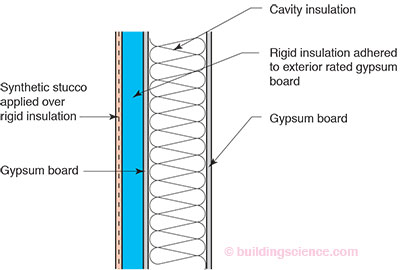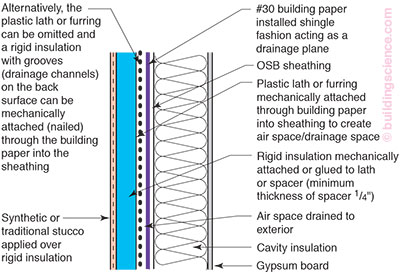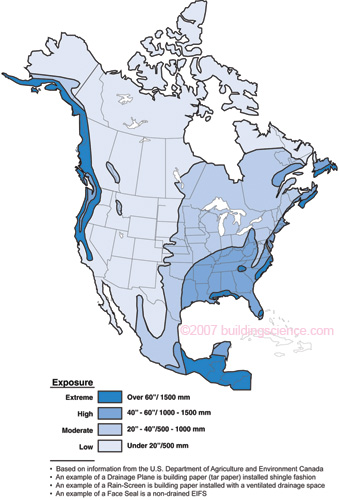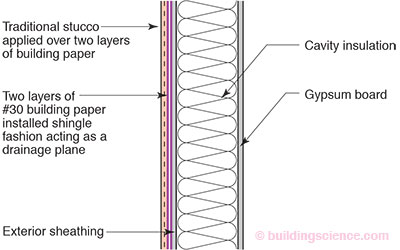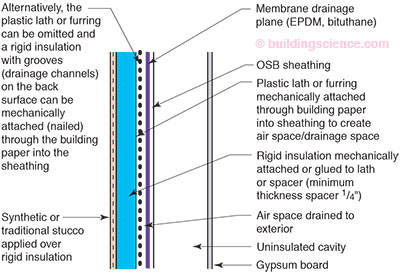Exterior insulation and finishing systems (EIFS) are inherently defective and unfit of use as an exterior cladding system where moisture sensitive components are used without a provision for drainage or in locations and assemblies without adequate drying. Exterior insulation and finishing systems (EIFS) are inherently defective and unfit to use as an exterior cladding system where moisture sensitive components are used without a provision for drainage or in locations and assemblies without adequate drying.
The Problem Defined
Exterior insulation and finishing systems (EIFS) are inherently defective and unfit for use as an exterior cladding system where moisture sensitive components are used without a provision for drainage or in locations and assemblies without adequate drying. Their use should be limited to hot-dry climates (Figure 1). A hot-dry climate is defined as a region that receives less than 20 inches of annual precipitation and where the monthly average outdoor temperature remains above 45° F throughout the year.
Figure 1: Hygrothermal Regions
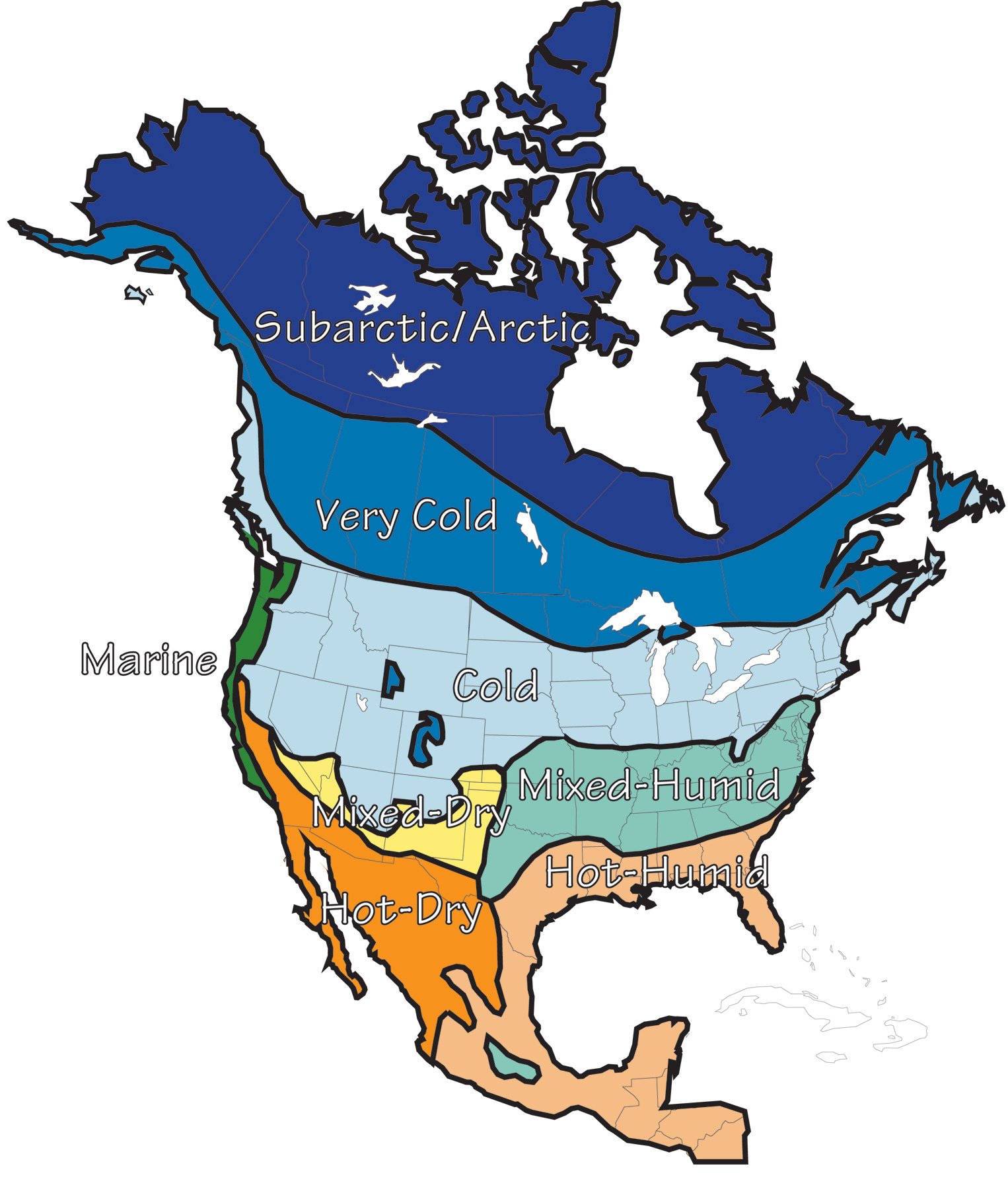
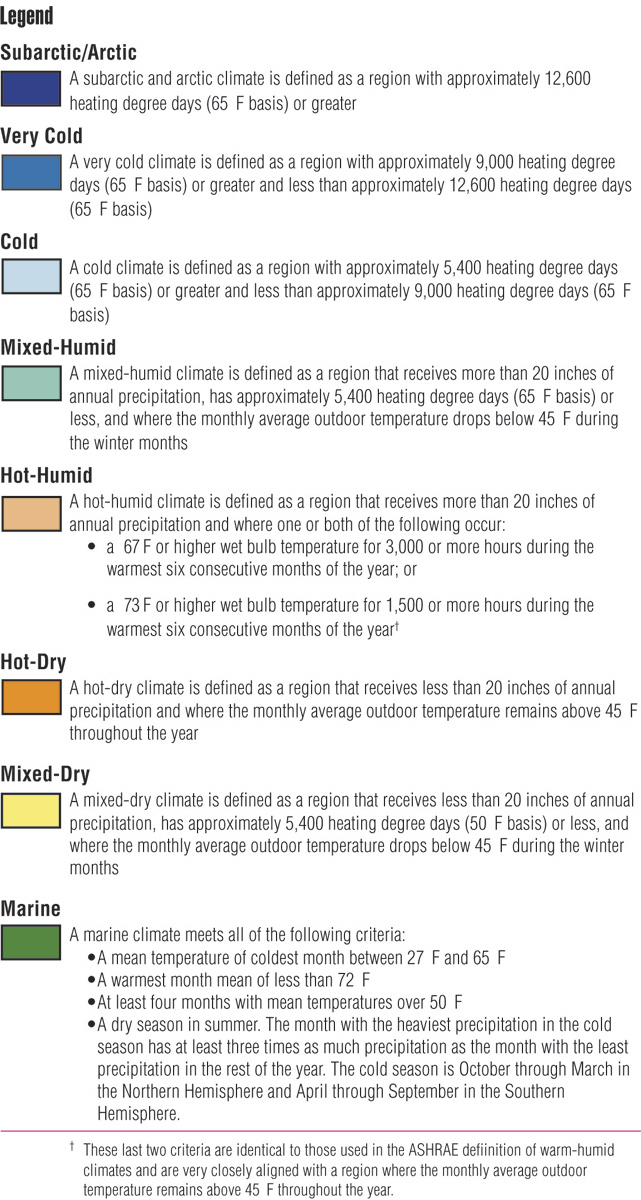
Typical EIFS are barrier or face-sealed systems that by definition have no provision for drainage. The typical system also contains moisture sensitive materials. Specifically, the following moisture sensitive components are used: exterior gypsum board, oriented strand board (OSB) or plywood sheathing, metal or wood studs, fiberglass cavity insulation and interior gypsum board sheathing (Figure 2).
Figure 2: Face-Sealed EIFS
Drainable EIFS are significantly different from face-sealed or barrier systems in that by definition they have a provision for drainage (Figure 3). Unlike face-sealed or barrier systems – except where they are used in hot-dry climates, drainable EIFS are not inherently defective and therefore are fit for use as an exterior cladding system in most climates. Drainable EIFS are not subject to the same limitations of use of face-sealed or barrier systems. In fact, drainable EIFS are among the most robust and advanced moisture control assemblies available.
Figure 3: Drainable EIFS
The Effects of Climate
The exterior and interior climates in many regions throughout North America provide limited drying potentials due to high relative humidities throughout the year. This is particularly a problem in hot-humid and mixed-humid climates. This limited drying potential provides inadequate drying for EIFS where moisture sensitive components are used without a provision for drainage. This is exacerbated with the installation of interior vapor barriers or impermeable interior finishes such as vinyl wall coverings.
Moisture damage is in essence a rate question. When the rate of wetting is greater than the rate of drying, accumulation occurs. When the quantity of accumulated moisture exceeds the moisture storage capacity of a material, deterioration occurs.
The typical moisture damage in an EIFS assembly is deterioration due to mold, wood decay fungi and corrosion leading to decay, loss of strength and discoloration. The components principally affected are the interior and exterior gypsum sheathing, the metal or wood studs and the fiberglass cavity insulation. Less affected are the EIFS lamina and sealants.
The rate of wetting of a building assembly is a function of exposure, design, construction and operation/maintenance. The rate of drying of a building is a function of the same parameters. Exposure is substantially dominated by climate, but can be influenced by design factors such as building height, orientation, massing, overhangs, etc.
The principal wetting mechanism for EIFS assemblies is rain. As are all cladding systems, EIFS are sensitive to the frequency and severity of rain. The amount of rainfall deposited on a surface determines the type of approach necessary to control rain.
Figure 4 is a map of annual rainfall for North America. This map defines four rain exposure regions based on annual rainfall: extreme, high, moderate and low. In all but low rain exposure regions, face-sealed or barrier systems used with moisture sensitive components should be avoided.
Figure 4: Rain Exposure Zones
Rain Control Strategies
Two broad types of rain control strategies are prevalent in building construction:
• barrier approaches
• water managed approaches
The barrier approach is traditionally used with heavy, massive, solid non-water sensitive construction such as stone, brick, masonry and concrete structures. The water managed approach is traditionally used with light, hollow, water sensitive construction such as wood frame, curtain wall and steel frame structures.
The barrier approach assumes that some rain water will pass through the cladding system into the wall assembly. In general, this rain water is stored in the mass of the wall assembly until drying by diffusion, capillarity and air flow occurs to either the exterior or interior. The barrier approach relies on water resistant materials, a significant reservoir or storage capacity, low wetting potentials and high drying potentials. Historically speaking this is the oldest technology used for rain control.
The water managed approach also assumes that some rain water will pass through the cladding or face of the wall assembly. However, the majority of this rain water is drained back to the exterior. A drainage plane is installed behind the exterior cladding to facilitate this drainage. This drainage plane requires a drainage space (air gap) and weep openings to function. The drainage space allows rain water to drain between the drainage plane and the exterior cladding and the weep openings direct the draining rain water to the exterior out of the wall assembly. The small amount of rain water that does not drain back to the exterior, dries by diffusion, capillarity and air flow to either the exterior or the interior as in the barrier approach.
Traditional Stucco
Traditional stucco claddings have successfully employed both the barrier approach and the water managed approach. Traditional stucco using the barrier approach is common to masonry walls that are rendered on the exterior with a Portland cement based stucco. A vapor permeable paint is often used over the stucco rendering to reduce rain water absorption while still allowing drying to the exterior. Interior finishes are typically vapor permeable and held away from the interior masonry surface to promote drying to the interior. The rain water that enters through the stucco face is harmlessly stored in the masonry wall until it can dry to either the interior or to the exterior.
Traditional stucco using the water managed approach (Figure 5) is common to wood frame or steel stud walls that are sheathed with plywood or gypsum board. Two layers of building paper and metal lath are installed shingle fashion over the exterior sheathing. A Portland cement based stucco is then rendered over the metal lath and building papers. The building papers absorb water, swell and wrinkle. After application, the building papers dry, shrink and the stucco rendering debonds from the building papers creating a drainage space. The drainage space is connected to weep screeds or flashings completing the system. The water that enters through the stucco face is drained back to the exterior by the drainage plane and the weep screeds or flashing system.
Figure 5: Traditional Stucco
Traditional stucco systems recognize the obvious – stucco cracks. Furthermore, since traditional stucco cracks, traditional stucco systems leak. Since traditional stucco systems leak, the leaking rain water must be addressed. This is done either by constructing assemblies from water resistant materials such as masonry and relying on high drying potentials or by using water management – drainage planes, drainage spaces and flashing systems.
Traditional Cladding
Traditional cladding systems also recognize the obvious – cladding systems leak. Brick leaks, wood siding leaks, vinyl siding leaks, stone leaks, granite leaks, stucco leaks, hardboard siding leaks, precast concrete leaks, curtain wall assemblies leak – everything leaks. Since everything leaks, assemblies are constructed out of water resistant materials or they are drained. This is a fundamental rule of design and construction.
There is only one exception to this almost universal rule. The exception occurs in places where it doesn’t rain very much and where the outside air is dry almost year round. In dry climates, with less than 20 inches of annual precipitation, almost anything can be built using any type of material. In these climates, walls don’t get very wet and they dry out quickly. The rate of wetting is low while the rate of drying is high – accumulation rarely occurs and moisture sensitive materials can be used in the barrier approach.
Traditional construction recognizes something else that is also obvious – it is not possible to rely on perfect workmanship and perfect materials. People are imperfect and materials are imperfect. There are limitations to what can be expected of individuals in the field and there is variation in the quality of materials – from sealants to the grade of wood, from the density of foam sheathing to the permeability of paint.
Where it rains, rain will enter. Period. How much rain enters is a function of exposure, design, workmanship and operation/
maintenance. But make no mistake, rain will enter. That is why the rain must be let out after it enters, or the wall must be built in such a way that the rain entry doesn’t matter.
Face-Sealed EIFS
Relying on perfect workmanship and perfect materials to keep rain out, in a location where it rains, is a fundamental flaw in logic. It is contrary to historical experience and contrary to human nature. This is why EIFS are inherently defective and unfit for use as exterior cladding systems where moisture sensitive components are used without a provision for drainage or in locations without adequate drying. Adequate drying will occur in locations with high drying potentials – locations where, in essence, it does not rain much.
Rain water enters EIFS through cracks in the EIFS, between the EIFS lamina and windows, through balcony elements, through railings, through windows, through sliding doors, through service penetrations and through the roof system. That rain water enters should not be a surprise since, for all practical purposes, rain water entry is impossible to prevent.
Sealants and Joints
Relying on sealants to prevent rain water entry by eliminating openings is one of the key fundamental flaws in the logic of the EIFS – since the sealant material must be perfect and the installation of the sealant must be perfect.
It may be possible to install sealant in one joint perfectly – if the surfaces are clean, dry, dust free and the correct sealant, backer rod and gap are provided. Let us also assume good weather, not too cold, not too hot, not raining. But how about installing sealant perfectly in 10 joints?
Is it possible for a technician to install sealant perfectly in 10 joints in a row? Let us assume perfectly prepared joints: joints that are “backwrapped” properly, with the correct gap. It is probably possible – a conscientious, properly trained, supervised technician could do 10 perfect joints in a row.
Now how about 100 joints? Recall, that the joints must be perfectly prepared and that this preparation is dependent on other trades and technicians: the window installation contractor and the foam and lamina application technician. I think most rational people would have a problem with 100 perfect joints. But the requirement for 100 perfect joints is nothing – a drop in the bucket for what is required. How about 1,000 perfect joints? Or 10,000 perfect joints? Now we are getting just a little bit outrageous. Yet, this is what is required of EIFS constructed with moisture sensitive components without a provision for drainage or in location without adequate drying.
But on the subject of joints, we are just beginning. How do you select the sealant? Well, the material must adhere to the lamina, must be resistant to ultra-violet light; the base coat bond strength to the rigid insulation (EPS) must be greater than the sealant bond; and the material also has to be affordable. Does such a sealant exist? In short, no. But let’s assume that such a material does exist – and ask the next important questions.
How long should this joint last? How can you tell when the sealant in the joint needs to be replaced or how can you tell when the joint needs to be rehabilitated? How do you replace sealant in joints? How do you rehabilitate sealant joints? Can in fact any of this be done? It is the new millennium and the arguments around these questions continue to rage – no consensus exists within the EIFS industry – consensus certainly does not exist among consultants engaged in the rehabilitation of EIFS. Certainly no one even had a clue in the 1980s when face-sealed EIFS began to be marketed – except that it couldn’t be done. How could a system be marketed in the 1980s with such an overwhelming performance requirement on sealant joints when the question of sealant joint longevity, replacement and rehabilitation had not been adequately addressed?
To put this into perspective, there are more than 1,000 sealant joints per building in most commercial EIFS buildings. Most of the joints leak from day one. More joints leak as the building age. Many EIFS buildings are now over 10 years old. It is time to replace the joints? What to do? That’s easy, remove all existing sealant and rehabilitate the joints. How do you do that? How do you prepare the surfaces to take new sealant? You think installing the sealant perfectly the first time was difficult – how about after the building has aged a decade? Oh, by the way, all the windows leak. Now what? What indeed. A system that relies on perfect joints, sealed perfectly, with perfect windows is fundamentally, inherently defective. The system, if it is constructed with moisture sensitive materials in a climate where it rains and has a high humidity, is unfit for the intended use.
Cracking
Traditional stucco cracks due to drying shrinkage or hygric stresses, embrittlement due to aging, and building movement. EIFS laminas do the same thing for essentially the same reasons. It is not possible to prevent traditional stucco from cracking. The same holds true for EIFS laminas. If there are cracks, there will be rain entry – and there will be cracks because it is impossible not to have them.
If drying shrinkage or hygric stress were not an issue in EIFS laminas, mesh reinforcing would not be necessary. The function of mesh reinforcing is to distribute the hygric stresses throughout the lamina rather than allowing stress relief to occur at a single location such as a crack. In the most fundamental sense a crack is stress relief. When cracking begins to occur, an additional function of the mesh reinforcing is to promote micro-cracking – many tiny cracks rather than fewer larger cracks, and to limit crack propagation – short cracks rather than long ones. More mesh reinforcing provides more effective distribution of hygric stresses, effectively promotes micro-cracking and limits crack propagation.
Unfortunately, the use of fiberglass mesh in an alkaline environment leads to the deterioration of the fiberglass mesh. To compensate for this, the mesh is coated and the alkaline environment is buffered chemically. However, prolonged exposure of the lamina to moisture leads to a loss of strength of the fiberglass mesh. This mechanism of deterioration can only be slowed, not stopped or prevented. There is no known solution to this problem. To further compensate for this problem, more mesh reinforcing and thicker mesh reinforcing is used. The logic being: if it’s going to get weaker, make it stronger than you need initially, so that later it will still be strong enough. The flaw in this logic is the definition of “later.” Does later mean 1 year, 3 years, 5 years, 10 years, 25 years or 50 years? “Later” also depends on exposure. Ten years in Las Vegas is very different from 10 years in Columbia, SC. It appears that after 10 years in a moderate rain exposure region, significant deterioration of fiberglass mesh occurs.
Unfortunately, more mesh reinforcing leads to a thicker lamina, which decreases the elasticity of the system. To compensate for this problem, the elasticity of the system is increased by increasing the acrylic content. However, as the acrylic content is increased the permeability of the lamina is decreased while the sensitivity of the lamina to ultraviolet light (solar radiation) is increased. A decrease in permeability, of course, leads to a reduction in drying to the exterior.
The exposure to ultra-violet light leads to embrittlement and a decrease in elasticity of the system. The acrylic content also interferes with hydration and makes the lamina more sensitive to carbonation – a reaction with atmospheric carbon dioxide – that leads to embrittlement and a decrease in elasticity. In other words, as the system ages, the lamina becomes more brittle and subject to cracking.
Taking into account hygric stresses and embrittlement due to aging is one thing. Building movement is an entirely different – and serious matter. In the realm of the obvious, building movement is another given: buildings move. All buildings move. Tall buildings move more than short buildings – especially tall concrete frame buildings. Since all buildings move, control joints are necessary. If control joints are not provided, the building provides its own in the form of cracks. Arguing that control joints are not necessary in buildings is another fundamental flaw in logic that is contrary to experience and the laws of physics.
Tall concrete frame buildings are subject to frame shortening due to the mechanism of concrete creep, a fundamental characteristic of concrete experiencing loading over an extended period of time. The weight of a tall concrete building causes the columns to shorten by swelling. In order to take this into account, control joints are typically provided through the cladding system at every floor. It is inconceivable to argue rationally that this does not happen and that exterior cladding systems are flexible enough to take into account this movement.
EIFS laminas crack – every one of them. Some EIFS laminas crack sooner than others, but they all eventually crack. The cracks are due to hygric stresses, embrittlement due to aging and building movement. The cracks in EIFS laminas are often found initially at reveals and at window openings. The hygric stresses and building movement stresses typically concentrate at locations where there is a change in thickness, a change in direction or at a termination such as an opening.
As mentioned earlier, rain water entry occurs through cracks in the EIFS lamina, between the EIFS lamina and windows, through balcony elements, through railings, through windows, through sliding doors, through service penetrations and through the roof system leads to moisture damage.
Moisture Damage
Moisture damage is defined as deterioration due to mold, decay, corrosion, loss of strength, dimensional instability, freeze-thaw action, mineral or soluble salt spalling, deterioration of surfaces and volatile organic compound (v.o.c.) or odor emission.
The sensitivity of material to moisture is described by a damage function – typically a time, temperature and moisture content relationship specific to a particular deterioration mechanism such as mold, decay or corrosion.
The moisture damage typically observed with EIFS includes the following:
• mold growth on gypsum board and fiberglass cavity insulation surfaces
• loss of cohesive strength of gypsum board or OSB sheathing
• corrosion of metal studs
• discoloration of interior and exterior surfaces
• volatile organic compound (v.o.c.) or odor emission
• water damage to interior furnishings such as carpet
• dimensional instability – loss of cohesive and adhesive properties of sealantlamina interfaces
Gypsum board is an extremely moisture sensitive material and has an extremely low moisture storage capacity. It must be protected from water in both the liquid and vapor forms. Paper faced gypsum board is particularly sensitive to mold growth and loss of strength when exposed to water. OSB sheathing is not much better.
The moisture storage capacity of hygroscopic materials such as gypsum board is time and temperature dependent. The acceptable hygroscopic performance limits for gypsum board are typically established by mold growth rather than loss of strength. Mold growth on gypsum board can occur due to elevated relative humidity. The presence of liquid water from rain water leakage, ground water leakage, condensation or plumbing leaks is not necessary.
Mold growth occurs on gypsum board when the water activity of the gypsum surfaces exceeds 0.7 for more than two weeks at a temperature greater than 45 degrees F. and less than 100 degrees F. As the temperature (within this range) and relative humidity rise, the time period for mold establishment and amplification shortens. Mold growth will appear on gypsum board within 48 hours at a water activity of 0.9 at 75 degrees F.
In general, water activity is directly related to relative humidity. For example, a water activity of 0.7 is achieved when a hygroscopic material is in moisture equilibrium with air at a relative humidity of 70 per cent. Water activity should not be confused with moisture content. The moisture content of gypsum sheathing when it is at equilibrium with are at a relative humidity of 70 percent is approximately 0.5 percent by weight.
Loss of cohesive strength in gypsum sheathing occurs at moisture contents of 2 to 3 percent by weight or greater and requires the presence of liquid water. Loss of cohesive strength of gypsum sheathing cannot be attributed to high relative humidities alone – liquid water due to water leakage or due to condensation is necessary.
Metal studs are also moisture sensitive and are subject to corrosion. Metal studs begin to corrode in air at a relative humidity of 70 percent or more. The rate of corrosion is dependent on temperature and available moisture. The time required for corrosion to become initiated depends on the degree of protection. For example, steel studs are galvanized to protect the steel from corrosion.
However, the zinc galvanic coating is sacrificial – it disappears over time as it protects the steel. Thicker galvanization provides a great time period or protection before corrosion occurs. Additionally, the coating must be continuous. Where steel studs are cut, where screws penetrate or where scratches occur, the coating is breached and corrosion can begin if sufficient moisture is available.
Steel studs are typically galvanized only to the extent necessary to protect the steel from water and humidity during the construction process. Galvanization is not relied upon to provide long term protection for the assembly. It is for this reason that galvanized steel studs are considered to be a moisture sensitive component. Long term protection for steel studs is typically provided by keeping the assembly dry.
Wood studs and wood based sheathings such as OSB and plywood are also moisture sensitive and are subject to decay and surface mold growth. When wood studs, OSB and plywood are exposed to relative humidities of 80 percent or more, mold can colonize the surfaces. These conditions approximate an equilibrium moisture content of 16 percent by weight in the wood or a water activity of 0.8 at wood surfaces. When moisture content by weight exceeds fiber saturation – typically 28 percent – decay can occur. Once decay is initiated, it will continue until moisture content by weight is dropped below 20 percent. Long term protection for wood studs and wood based sheathings is typically by keeping the assembly dry. Treating wood with biocides is not considered long term protection – they are considered sacrificial and therefore temporary.
Fiberglass cavity insulation is composed of glass fibers coated with a binder. The binder provides stiffness and binds the fiberglass layers to one another creating a mat. The glass fiber mat is covered on one side with a draft paper impregnated with bitumen. The binder is principally phenol-formaldehyde, with urea formaldehyde as an extender. When relative humidities exceed 70 percent, the urea binder off-gasses, leading to a distinct urine odor. Mold growth also occurs on both the fiberglass and the kraft paper surfaces. Fiberglass fibers themselves do not rot; however, the kraft facing does when it becomes saturated with water.
The moisture sensitivity of the gypsum board or OSB exterior sheathing, the metal or wood studs and the fiberglass wall cavity insulation make them unsuitable for use with a barrier system in all but dry climates. The use of such moisture sensitive materials makes the EIFS inherently defective and unfit for use as an exterior cladding system in much of North America – with the exception of hot-dry climates or regions with less than 20 inches of annual precipitation.
To use EIFS safely in regions with more than 20 inches of annual precipitation it must be used with a wall assembly that manages rain water. Such assemblies also must not contain interior vapor barriers or impermeable interior finishes. An exception to this requirement is where the drainage plane is a membrane that is also a vapor barrier and an air barrier and the interior framing cavities are uninsulated (Figure 6).
Figure 6: Drainable EIFS with Membrane Drainage Plane

